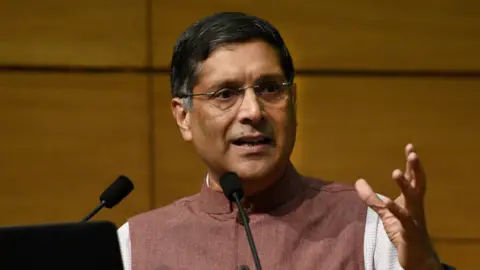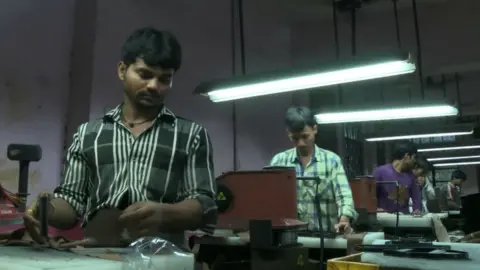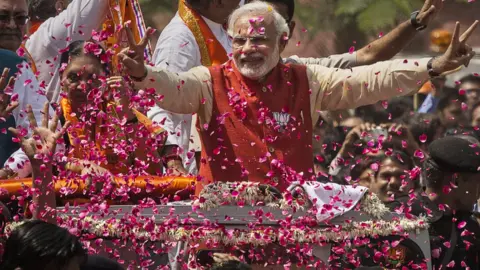Is India exaggerating its economic growth?
India's economic growth might be overestimated, according to the country's former chief economic adviser.
In a column published in an Indian newspaper, Arvind Subramanian said his research shows India has changed how it measures growth - and this led to its gross domestic product (GDP) being overstated by about 2.5% annually.
Prime Minister Narendra Modi's panel of economic advisers has rejected his conclusions, adding it would soon issue a "point-to-point rebuttal".
Mr Subramanian's observations have, however, reignited concerns about the credibility of India's economic growth data.
It was the fastest growing economy in 2018 but many leading economists have argued the new methodology is flawed as it does not truly reflect the economy.
What's the controversy?
In 2015, India changed the way it measured GDP.
One of the major changes: GDP is now measured by using market prices rather than basic costs. Simply put, the GDP was used to be calculated based on the wholesale prices at which producers received their products. Now, it's calculated based on the market prices paid by consumers.
And the base year was shifted from 2004-05 to 2011-12 to assess quarterly and annual growth figures. Since then, the methodology has been under scrutiny from economists and statisticians.
 Getty Images
Getty ImagesMr Subramanian has reinforced those doubts by claiming that the economic growth for the period between the financial years 2011-12 and 2016-17 is exaggerated. While official estimates put it at 7%, he pegs the "actual growth" at about 4.5%.
His comments are based on his own research, which has been published by the Centre for International Development at Harvard University.
Since 2015 - when the new methodology came into effect - a growing number of experts have questioned the high growth estimates under Prime Minister Narendra Modi's government.
Despite the his government's claims of rapid growth, unemployment touched a 45-year high between 2017 and 2018.

Raghuram Rajan, former head of India's central bank and former chief economist of the International Monetary Fund, has expressed doubts over the data given the high rate of joblessness.
What does the Indian government say?
The government has defended its methodology for calculating economic growth.
"India objectively measures the contribution of various sectors in the economy and the country's GDP estimates are based on accepted procedures and methodologies," India's statistics ministry said in a statement.
This is the not the first time that the government has been questioned over data collection. A study by the statistics ministry found that in the fiscal year which ended June 2016, 36% of companies in the database used for calculating India's GDP could not be traced or were wrongly classified.

Read more about the Indian economy

The government itself has admitted there are deficiencies in the way it collets data.
Mr Subramanian has called for an independent panel of experts comprising Indian and foreign nationals to examine India's GDP data.
"My new research suggests that post-global financial crisis, the heady narrative of a guns-blazing India - that statisticians led us to believe - may have to cede to a more realistic one of an economy growing solidly but not spectacularly," Mr Subramanian writes.
How will this affect India?
It's a big blow for Mr Modi's government, which recently won a second term but is already under pressure to revive economic growth.
The government's own figures admit that India is no longer the fastest growing economy - it lost that tag to China when its GDP grew at its slowest pace in five years.
Not only could this hurt India's reputation but it also highlights how economic policies implemented over the past few years may have actually impeded growth by giving an inaccurate picture of the economy.
 Getty Images
Getty ImagesFor example, interest rates in India were kept high to tackle inflation but that created more barriers for businesses, forcing them to borrow capital at a high cost. To make matters worse, the unravelling of the bad loans crisis impacted banks, making it difficult to access money.
The central bank lowered interest rates thrice this year to boost the economy after growth started to falter.
The lack of jobs and the agrarian crisis gripping India are two huge challenges that have weighed down economic growth.
 AFP
AFPApart from restoring confidence in the economy, experts say there is an urgent need to revamp the statistical system to capture real-time data for policy analysis. The government has said that it's working with the World Bank to modernise the way data is collected
Mr Modi has set up committees to device policies that would help attract investment and create employment. Given the gloomy outlook on India's economy, Mr Subramanian, too, expects the government to act swiftly to tackle the slowdown.
"Going forward, there must be reform urgency stemming from the new knowledge that growth has been tepid, not torrid," he writes.
